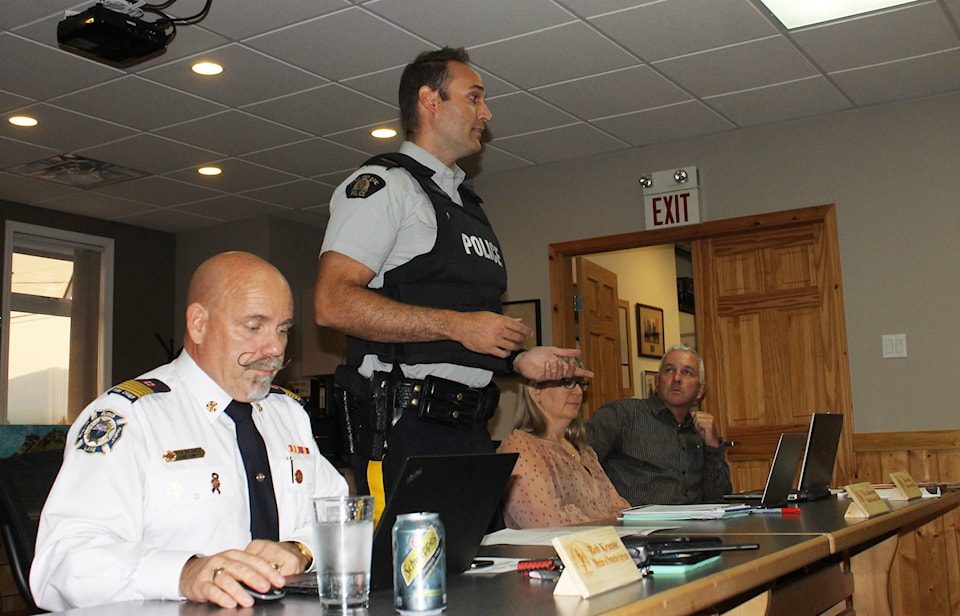Targeting the so-called “red zone” in Burns Lake’s downtown core has led to a decrease in public intoxication in 2017 compared to the previous year, according to the Burns Lake RCMP.
The red zone stretches from Hwy. 16 - between Third Avenue and the Lakeview Mall - to Burns Lake. The pilot project was implemented on June 7, 2017, effectively turning a portion of the downtown core into a “zero tolerance” zone.
According to Corporal Greg Willcocks with the Burns Lake RCMP, possession of alcohol in a public place and public intoxication saw a reduction of 21 per cent in the red zone in 2017 - from June 1 to Aug. 30 - compared to the same period in 2016.
“We are quite happy with that,” said Willcocks. “Our goal was to be very visible to everybody in the community and to interact with people.”
In total, RCMP officers conducted 270 foot patrols between June 8 and Aug. 30, 2017. Each of these patrols were conducted by one or more RCMP officers and lasted between 30 minutes to an hour.
“A lot of our work has been proactive,” said Willcocks. “When we initiate a file in the red zone, it’s not necessarily because we received a call for service from the public, it’s because we found the offence being committed and acted on it appropriately.”
Willcocks said targeting the red zone may have also had an impact on the broader detachment coverage area, which saw a reduction of 26 per cent in alcohol related cases. And when combining alcohol related offences with “causing disturbance” offences, Burns Lake saw a decrease of approximately 15 per cent in the second quarter compared to 2016.
“Last year we found that only 10 per cent of the assaults occurred in the red zone; but when we dug deeper into that, we found that initially they were down here [in the red zone], and then they go to other areas and cause issues there because they are intoxicated,” Willcocks explained earlier this year. “Our theory with this model is that, if we’re proactive and deal with this [substance abuse issue] before people go out and commit other offences, we’re actually reducing the amount of crime in other areas.”
Willcocks added hat targeting the red zone is not just about enforcement. The RCMP has partnered with the Village of Burns Lake to connect people struggling with substance abuse with local addiction services.
“When we go and interact with people, we not only interact with them as police officers, but we also educate them,” he said. “I think that education has helped.”
Burns Lake council said they were pleased with the frequent RCMP patrols in the downtown core.
“That’s really exciting that you’ve had 270 foot patrols,” said councillor Susan Schienbein. “I have seen a couple members when I’ve been out driving, day and night, and it’s awesome to see it; if that’s what’s attributing to some of those decreases that’s really fabulous.”
Burns Lake Mayor Chris Beach said this initiative has also contributed to the popularity of the municipal campground this summer.
“The community is genuinely more comfortable going down there,” said Beach. “It makes a big difference.”
Councillor Kelly Holliday added that she noticed a minimal amount of graffiti and vandalism this summer and that she believes the frequent patrols have made a difference.
Spike in break and enters
Although public intoxication is down compared to last year, the Burns Lake RCMP detachment has seen a significant spike in the number of break and enters.
In the second quarter of 2017, Burns Lake had 23 break and enters. During the same period in 2016, eight cases were reported. However, according to corporal Greg Willcocks with the Burns Lake RCMP, these numbers can be misleading.
“When you look at the incidents that are happening, some are legitimate break and enters - somebody has gone into someone’s house when they were gone, maybe broke a window to get in or a door to get in; sometimes items are stolen and sometimes they are not,” he explained. “But we also had a lot of cases where it is called a break and enter, but it is really someone unwanted in the premise; nothing is actually damaged, but they come uninvited into the house.”
Earlier this summer, Burns Lake resident Sandra Lynn Brocklebank-elrick described how she found a strange man walking inside her home. Although she said that she wasn’t concerned for her safety, she worries that there might not be enough support for people struggling with addictions or mental health issues in the Burns Lake area.
Burns Lake council will meet with B.C.’s Ministry of Health to discuss mental health and addiction issues at the upcoming Union of B.C. Municipalities convention, which will take place on Sept. 25-29, 2017.
